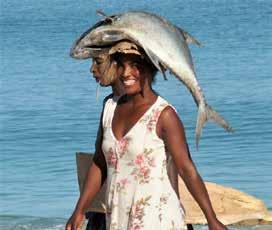
3 minute read
Country Facts



MADAGASCAR
165 million years ago, Madagascar already showed its uniqueness and originality by breaking away from the African continent to land 40 million years later, somewhere in the Tropic of Capricorn, in the shadow of the African continent with which it has so little in common. This island continent is known for its rich biodiversity: The luxurious tropical forest in the East, the desert like aridity in the South, the vast Savannahs in the West, the lush rice fields and terraces of the central highlands and its volcanic region and the turquoise lagoons in the North. The variety of climates, vegetation, landscapes, ways of life, habitats and traditions. The incredible melting pot of Asians, Arabs, Africans and the Europeans gave the island continent its personality and its biodiversity. The evolution of the living species of the Grande Ile or literally: “Great Island” has followed a different path from that of the neighboring continents. This enables every traveler to be submerged in a particularly unique flora and fauna, endemic to Madagascar.



THE COUNTRY
Location Madagascar lies in the Indian Ocean, 400 km off the African coast from which it is separated by the Mozambique Channel. Réunion Island is 700 km East and Mauritius at 900 km. Surface Area
587 000 km². Length from north to south is 1500 km and width from east to west is 500 km.
Population 27 million according to estimates made in 2019.
Density 42 inhabitants per square kilometer.
WEATHER
Not far from the equator, Madagascar has both dry and rainy seasons. The rainy season runs from mid-December to mid-March with the probability of tropical storms to cyclones, thus not the best season to travel, but it remains possible to visit some regions. The months of April to June after the rainy season are good for travel with a pleasant and mild climate. The country is lush and green after the rainy season. July and August are the southern winter months and can be cool in the mornings in the highlands. September to mid-December are ideal for traveling around the country.
In summary: April to November is the best time to visit Madagascar.
OCT – MAR APR – SEP
Antanarivo 17-26
Nosy Bè 21-31 10-22
19-30
MADAGASCAR
Ethnic groups 18 as well as minority communities like the Comoros, the Indo-Pakistani and Chinese. The French are the largest European community with nearly 25,000 citizens.
Capital Antananarivo (Tana) with 2.5 million inhabitants.
Main cities Antsiranana (Diego Suarez) to the north, Majunga (Mahajanga) northwest, Tamatave (Toamasina, the first port in the country) on the east coast, Antsirabe and Fianarantsoa in southcentral and Tulear (Toliara) to the southwest.
Government Independent Republic with an elected president endowed with the following institutions: Senate, National Assembly and Prime Minister.
Languages spoken The official language is Malagasy (spoken throughout the island), with several regional dialects, and French.
Currency Ariary (MGA) has officially replaced the Malagasy Franc since 2005. The foreign currency used is the Euro.
Religion: A large part of the population (about 44%) practices indigenous beliefs and rituals that accompany it. Catholicism and Protestantism represent approximately 22% of the population. A small minority of the population are Muslims (not exceeding 2% of the population).










